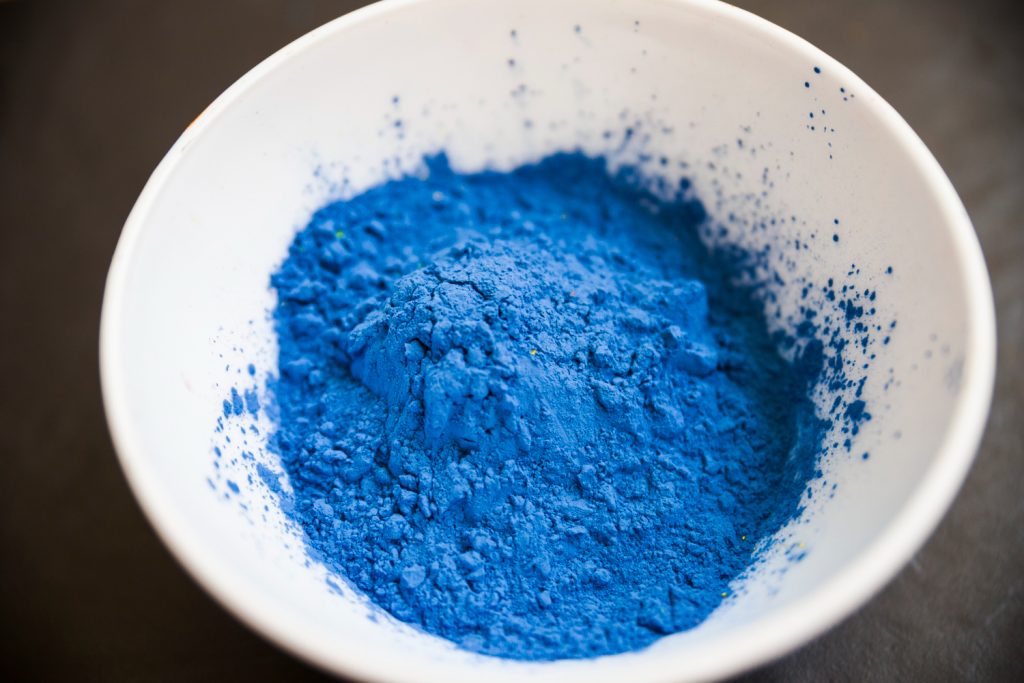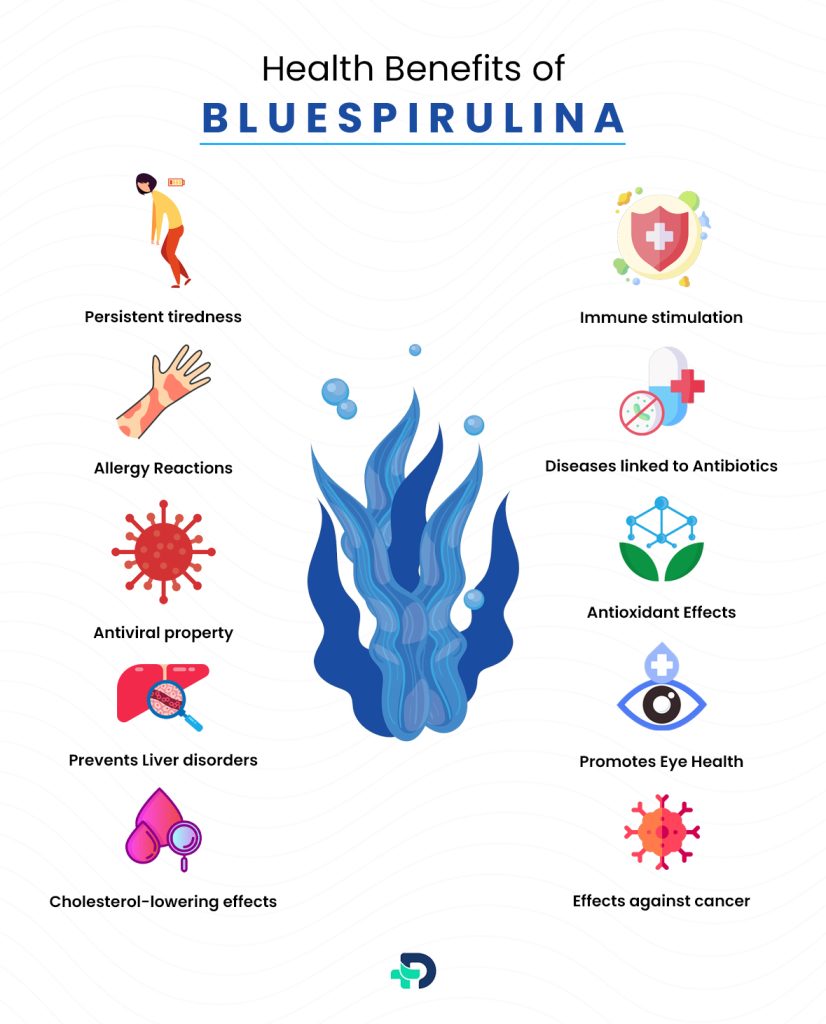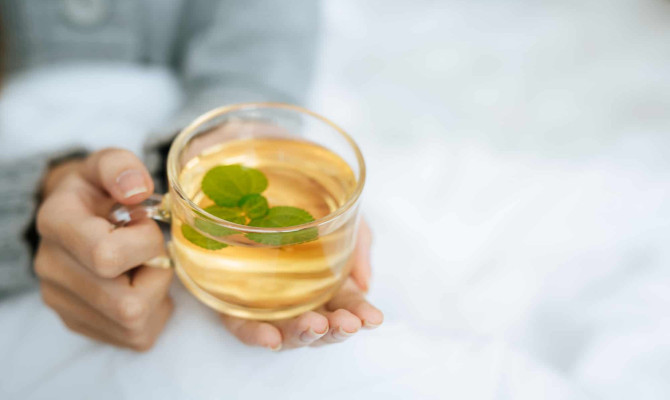What Is Blue Spirulina? Benefits, Safety & Interactions

- Spirulina
- 15 Sep 2023
Introduction
What is Blue Spirulina?
Blue spirulina, a form of blue-green algae, is a nutrient-rich meal that aids in protecting cells from injury. In addition to other nutrients, it typically contains high levels of proteins, vitamins, minerals, carotenoids, and antioxidants such as vitamin B complex, beta-carotene, vitamin E, manganese, zinc, copper, iron, selenium, and/or gamma-linolenic acid (a vital fatty acid). Blue spirulina is quite simple to grow, but it only thrives in lakes that are extremely alkaline and have a high pH. Only a few countries, notably Greece, Japan, India, the United States, and Spain, have the optimum sunny climate for the cultivation of this alga which is currently available in health food stores supplied as a dietary supplement in the form of beverages or pills.

In addition to serving as a protein supplement, many use blue spirulina to manage hypertension. It is also used to treat high blood cholesterol, despite the lack of solid scientific evidence, in addition to treating diabetes, obesity, high blood sugar, and other disorders. 1 Introduction | Researched based study from Mount Sinai Health System , 2 Introduction | Researched based study from National Library of Medicine
Health Benefits

What is Blue Spirulina good for?
Despite the lack of high-level evidence trials on the function performed by blue spirulina, based on a few research, blue spirulina can be regarded as a safe food supplement without noticeable side effects which has the following advantages as listed below:
- Prevents persistent tiredness
- Immune stimulation
- Prevents Allergy reactions
- Helps with diseases linked to Antibiotics
- Antiviral property
- Antioxidant Effects
- Prevents Liver disorders
- Promotes Eye health
- Cholesterol-lowering effects
- Effects against cancer.
Persistent tiredness
- Spirulina works by boosting the number of good lactobacillus bacteria in the colon, which contributes to patients’ having high energy levels and helps produce vitamin B6, which produces more energy and relieves chronic fatigue/tiredness in affected individuals.
Immune stimulation
- Nutritional deficits are known to alter immune function, which manifests as variances in T-cell generation, secretory IgA antibody response, cytokines, and NK-cell activity.
- Studies have shown that blue spirulina can influence the immune system by helping to make up for nutritional deficiencies.
Allergy Reactions
- According to studies, blue spirulina may prevent allergic reactions by preventing the release of histamines, which are substances that produce allergy symptoms such a runny nose, watery eyes, hives, and soft tissue swelling.
- It is unclear, though, whether allergy sufferers will benefit from this early research.
Diseases linked to Antibiotics
- Antibiotics target undesirable organisms in the body, but they can also kill probiotics, or “good” bacteria, such as Lactobacillus acidophilus. It may result in diarrhea.
- Blue spirulina has been shown to promote the growth of L. acidophilus and other probiotics in test tubes.
- Whether blue spirulina will have the same impact on people requires further study.
Antiviral property
- Studies in test tubes reveal that blue spirulina has antiviral properties against HIV, herpes, and influenza.
- To ascertain whether it could be advantageous for patients with the condition, more research is necessary.
Antioxidant Effects
- A potent antioxidant, blue spirulina aids in fighting off free radicals (unstable atoms that harm cells) and helps to reduce inflammation in the body, which lowers the susceptibility to any disease.
Prevents Liver disorders
- According to preliminary research, spirulina may help prevent cirrhosis (liver failure) and liver damage in those with chronic hepatitis.
- However, more conclusive studies are necessary to support its effectiveness in affected individuals.
Promotes Eye Health
- Spirulina has a high concentration of zeaxanthin, a crucial nutrient connected to eye health, which lowers the risk of cataracts and age-related macular degeneration, though further research is required to validate this benefit.
Cholesterol-lowering effects
- Few studies have demonstrated that persons with heart disease who took blue spirulina experienced improvements in blood cholesterol and triglycerides, demonstrating the impressive advantages of blue spirulina’s anti-inflammatory qualities on the heart.
- Even though it helps raise HDL (“good”) cholesterol and lower LDL (“bad”) cholesterol, more research is required to demonstrate its effectiveness in affected individuals.
Effects against cancer
It has been suggested that blue spirulina’s combined immune-modulating and antioxidant properties may have a mechanism for destroying tumors and a substantial role in the prevention of cancer, particularly oral malignancies. However, to prove this benefit, more study is necessary. 1 Health Benefits | Researched based study from Mount Sinai Health System , 2 Health Benefits | Researched based study from National Library of Medicine, 3 Health Benefits | Researched based study from Cleveland Clinic
Available Forms
Blue Spirulina – Available forms
- Blue spirulina is one of the substances on the US Food and Drug Administration (USFDA) list that are classified as “Safe”.
- Although it is quite simple to grow, this alga only thrives in lakes that are extremely alkaline and have a pH of over 8, and only in a selected few nation that have the ideal environment for growth.
- In health food stores, blue spirulina is currently supplied as a nutritional supplement in the form of pills, powder, or flakes which is mostly grown in laboratories for consumption in the United States. 1Available Forms | Researched based study from Mount Sinai Health System
Consumption
Consumption of Blue Spirulina
Can you take blue spirulina every day? How is blue spirulina consumed?
- Yes, blue spirulina can be taken daily if the doctor recommends it.
- Use blue spirulina only if has undergone testing to ensure that it is devoid of pollutants including heavy metals, or microcystins (liver toxins).
- Before using it, speak with your doctor to learn about the recommended dosage and time frame.
Use in adults:
- The recommended/standard dose for adults is 4 to 6 tablets (500 mg each) per day, which should be taken following consultation with a doctor who may propose the best dose based on the severity of the condition.
Use in children:
- The safe and effective dose of spirulina in children (aged below 18 years) is unknown, despite the fact that it has been used extensively in children.
- To avoid any undesirable effects, consult your healthcare provider before administering the medicine to the child. 1Consumption | Researched based study from Mount Sinai Health System
Is blue spirulina vegetarian?
- Yes, blue-green algae are indeed vegetarian which is sold as a dietary supplement in the form of pills, powder, or flakes that help to modulate immunological responses and have an anti-inflammatory effect by preventing mast cell histamine release in affected individuals. 2Consumption | Researched based study from National LIbrary of Medicine, 4 Consumption | Researched based study from Vegan friendly
Contraindications
Contraindications for Blue Spirulina
Who should not take blue spirulina?
Blue spirulina is contraindicated in patients who suffer from below conditions:
- Phenylketonuria (a rare metabolic disorder marked by the body’s inability to metabolize the amino acid phenylalanine)
- Autoimmune diseases such as multiple sclerosis, rheumatoid arthritis, or lupus. 1Contraindications | Researched based study from Mount Sinai Health System
Safety & Side Effects
Safety & Side effects of Blue Spirulina
Is Blue Spirulina Safe to Eat?
- When used for a brief period, blue spirulina (free from contamination) is relatively safe for the majority of people.
- For two months, doses as high as 19 grams per day with the lowest being 10 grams per day had been effectively administered with no side effects report after administrating blue spirulina.
The majority of side effects associated with the use of blue spirulina are minor which include –
- Headache
- Dizziness
- Nausea
- Vomiting
- Diarrhea
If blue spirulina gets contaminated, it is advised to avoid it since contaminated spirulina can harm the liver and can lead to conditions such as vomiting, weakness, rapid heartbeat, and/or shock in affected individuals. 5Safety and Side Effects | Researched based study from Medline Plus
Blue Vs. Green Spirulina
What distinguishes Blue from Green Spirulina?
- A single pigment-protein complex called phycocyanin accounts for the distinction between green, and blue spirulina in addition to providing various nutritional advantages.
- It is a potent antioxidant that is responsible for the distinctive blue color in blue spirulina which remains extracted in whole-cell algae thus terming it as green spirulina.
- Although green spirulina is the simplest to collect/harvest, it has fewer health benefits compared to that of blue spirulina which offers a fishier flavor, making it more difficult to incorporate into juices or smoothies. 6Blue Vs. Green Spirulina | Researched based study from Science Direct
Precautions
Warnings & Precautions for Blue Spirulina
Use in pregnant and breastfeeding women
- It is best to avoid using blue spirulina during pregnancy and breast-feeding because contaminated blue spirulina contains harmful toxins that could be passed on to a fetus during pregnancy or to an infant during breastfeeding resulting in undesirable effects.
Patients scheduled for surgery
- In light of the possibility that blue spirulina might lower blood sugar levels, there is some concern that it might impair blood sugar levels during, and after surgery.
- It is therefore advised to cease using blue spirulina at least two weeks before any necessary surgeries to avoid any undesirable effects. 5Precautions | Researched based study from Medline Plus
Interactions
Blue Spirulina-Interactions with medicines
Antidiabetic medicines (drugs used to treat diabetes):
- Blood sugar levels should be checked before administering the antidiabetic medicines since blue spirulina has the potential to lower the blood sugar level which may result in a severe drop when combined with antidiabetic medicines, thus caution should be practiced and healthcare provider should be consulted before taking the medicine to avoid undesired effects.
Immunosuppressants (medicines used to lower the effect of the immune system)
- Blue spirulina can boost immune system activity, which when combined with immunosuppressants (drugs used to reduce the immunological response following a transplant) can alter its effect thus before taking the medication, speak with your healthcare professional to prevent such occurrences.
Anticoagulant / Antiplatelet drugs (medicines that reduce the blood clotting process)
- When combined with anticoagulant drugs, blue spirulina may significantly reduce the blood clotting effect, which may raise the danger of bruising and bleeding in those who are affected.
- Hence to avoid such effects, it is advised to consult a healthcare professional before using blue spirulina. 5Interactions | Researched based study from Medline Plus
Herbs and supplements
- When combined with foods, herbal supplements, or medications that lower blood sugar, blue spirulina may induce a severe reduction in blood sugar levels which can be prevented by seeing a doctor before ingesting blue spirulina.
- Aloe, bitter melon, cassia cinnamon, chromium, and/or prickly pear cactus are a few supplements with this effect.
Iron
- The body’s ability to absorb iron can be reduced by blue spirulina which when combined with iron supplements may further reduce its absorption leading to undesired effects in the body, thus to avoid such effects, consult your doctor before taking blue spirulina.
Takeaway
Takeaway points for Blue Spirulina
- Blue spirulina is a type of blue-green algae that is rich in nutrients and helps to shield cells from harm.
- Blue spirulina is used as a protein supplement and a treatment for hypertension. Despite the lack of strong scientific proof, it is also used to treat excessive blood cholesterol in addition to diabetes, obesity, high blood sugar, and/or other illnesses in affected individuals.
- Blue spirulina is currently sold at health food stores as a nutritional supplement in the form of tablets, powder, or flakes.
- Despite being used frequently in youngsters, the safe and effective dose of spirulina for those under the age of 18 remains unknown. Before giving the medication to the child, speak with your healthcare practitioner to prevent any negative effects.
- Blue spirulina is contraindicated in patients who suffer from phenylketonuria (a rare metabolic disorder), and autoimmune diseases (such as multiple sclerosis, rheumatoid arthritis/lupus).
- The majority of blue spirulina adverse effects are minimal and include headache, nausea, dizziness, vomiting, and/or diarrhea.
- Blue spirulina should be avoided if it becomes contaminated since it can injure the liver and cause symptoms including vomiting, weakness, rapid heartbeat, and/or shock in those who consume it.
- A single pigment-protein complex called phycocyanin accounts for the distinction between green, and blue spirulina in addition to providing various nutritional advantages.
- Because contaminated blue spirulina contains dangerous toxins that could be transferred to a fetus during pregnancy or to a child during breastfeeding, resulting in undesired outcomes, it is advisable to avoid using blue spirulina during pregnancy and breastfeeding. 1Takeaway | Researched based study from Mount Sinai Health System , 2Takeaway | Researched based study from National Library of Medicine , 3Takeaway | Researched based study from Cleveland Clinic, 5Takeaway | Researched based study from Medline Plus, 6Takeaway | Researched based study from Science Direct
Any feedback on this article?
 This Articles content was accurate
This Articles content was accurate Very Informative Article
Very Informative Article I have a question or a comment
I have a question or a comment
 This article contains inaccurate content
This article contains inaccurate content This article was not helpful
This article was not helpful I have a question or a comment
I have a question or a comment
We appreciate your helpful feedback!
Checkout our social pages
References
-
Mount Sinai Health System
Introduction | Health Benefits | Available forms | Consumption | Contraindications | Takeaway
-
National Library of Medicine
Introduction | Health Benefits | Consumption | Takeaway
-
Cleveland Clinic
Health Benefits | Takeaway
-
VeganFriendly
Consumption
-
Medline Plus
Safety and Side Effects | Precautions | Interactions | Takeaway
-
Science Direct
Blue Vs. Green Spirulina | Takeaway






































